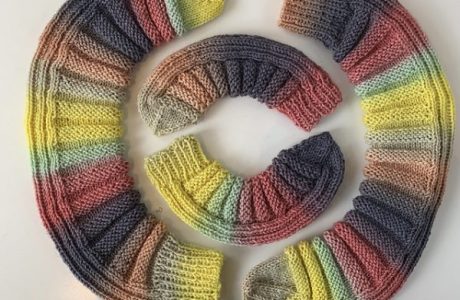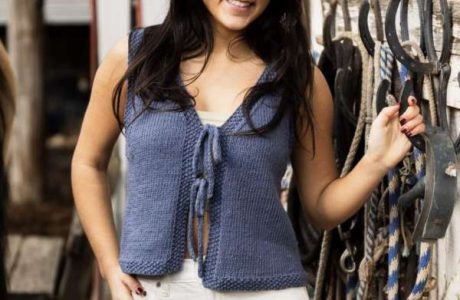 Brioche stitch isn’t hard. If you’ve knitted for any amount of time you automatically know that new stitches and techniques aren’t hard. There’s knit, purl, yarn over (increases) and decreases. That’s all there is to any stitch pattern.
Brioche stitch isn’t hard. If you’ve knitted for any amount of time you automatically know that new stitches and techniques aren’t hard. There’s knit, purl, yarn over (increases) and decreases. That’s all there is to any stitch pattern.
Easy!
With this tutorial from Knitting Daily of Interweave, learn how to do a Brioche Stitch.
Brioche Stitch
by Nancy Marchant
Brioche stitch produces a lofty, ridged fabric that resembles knit 1, purl 1 rib. Pronounced columns of elongated knit stitches appear to float on the surface above purl troughs. Because it is reversible, brioche stitch is a good choice for scarves, shawls, and blankets.
Brioche stitch belongs to a family of stitches that rely on slipped stitches worked in conjunction with yarnovers. On one row, a stitch is slipped, and at the same time, the yarn is carried over the needle to create a yarnover. On the next row, the slipped stitch and its adjacent yarnover are worked together.
Once you get accustomed to working with the paired slipped stitch and yarnover, you’ll find brioche stitch as simple to knit as ribbing.
Basic Brioche Stitch
The key to brioche stitch is the slipped stitch-yarnover unit. On the first row, the yarn is brought forward to the front of the work and the first stitch on the left needle is slipped to the right needle. When the next stitch is knitted, the yarn crosses the needles forming a yarnover. The maneuver is written as (sl 1 yo). On the following row, the slipped stitch is worked together with the yarnover. Most brioche patterns refer to this as “k2tog” but I like to call it “brioche-knit 1” (abbreviated “brk1”) to distinguish it from a decrease. The two steps are alternated stitch by stitch and row by row to produce the characteristic rib pattern. Think of the “sl 1 yo” as the purl stitch and the “brk1” as the knit stitch in regular knit 1, purl 1 rib. The yarnover is always worked together with the slipped stitch-it is never counted as a stitch by itself.
Sl 1 yo: Bring working yarn to front under the needle, slip 1 stitch, bring working yarn over top of needle to the back (Figure 1). This produces a yarnover that crosses over the slipped stitch. This combined slipped stitch/yarnover is counted as a single stitch. (Some books will describe this as a two-step process: “yo, sl 1” or “sl 1, yo.”) Remember: When you are working (sl 1 yo), the yarn must begin in front of the work.
Brk1: Knit the stitch that was slipped in the previous row together with its yarnover (Figure 2). Because the yarnover wasn’t counted as a separate stitch on the previous row, no real decrease is made.
To begin, loosely cast on an uneven number of stitches. The instructions here include a selvedge stitch at each edge, which gives the piece a finished look and greatly facilitates seaming.
Set-up row: Sl 1 knitwise with yarn in back (wyb; selvedge st), *sl 1 yo, k1; rep from * (last st is a selvedge st).
Row 1: Sl 1 knitwise wyb, *brk1 (slipped st and yo of previous row), sl 1 yo; rep from * to last 2 sts, brk1, k1.
Row 2: Sl 1 knitwise wyb, *sl 1 yo, brk1; rep from * to last 2 sts, sl 1 yo, k1.
Repeat Rows 1 and 2 for pattern.
The key to brioche stitch is the slipped stitch-yarnover unit. On one row, the yarn is brought to the front of the work as a stitch is slipped to the right needle, called “sl 1 yo” (Figure 1). On the following row, the slipped stitch is worked together with the yarnover, called “brk1” (Figure 2).
Two-Color Brioche Stitch
The Brioche Stitch Cardigan is done in two-color brioche stitch, which as the name implies, is worked with two colors.
The main color (MC) forms knit columns on the right side (RS) of the work and purl columns on the wrong side (WS); the contrast color (CC) forms knit columns on the wrong side and purl columns on the right side. Unlike single-color brioche stitch, both knit and purl stitches are used in two-color brioche. However, the fundamentals are the same: the pattern alternates between creating a slipped stitch-yarnover pair (sl 1 yo) and working the pair formed in the previous row together as one stitch. On right-side rows, the slipped stitch/yarnover pair is worked knitwise as a brioche-knit stitch (brk1); on wrong-side rows it is worked purlwise as a brioche-purl stitch (purl the slipped stitch together with its yarnover; abbreviated “brp1”). Again, the yarnovers are always associated with a slipped stitch. To maintain the pattern and color integrity, the colors alternate every row and two wrong-side rows are followed by two right-side rows.
To do this, you’ll need to use circular or double-pointed needles so that the stitches can be slid to the opposite needle tip and worked again without turning the work. To begin, loosely cast on an uneven number of stitches with MC as for single-color brioche stitch, but use circular or double-pointed needles. Do not join into a round, but work back and forth in rows.
Here’s a pattern for a practice swatch.
Cast on an uneven number of stitches.
Row 1: (WS; CC) With CC, sl 1 kwise (selvedge st), *k1, sl 1 yo; rep from * to last 2 sts, k2 (last st is selvedge st). Do not turn work.
Row 2: (WS; MC) Slide work to other tip of needle where MC is hanging. With MC, sl 1 pwise (selvedge st), *sl 1 yo, brp1 (slipped st and yo of previous row); rep from * to last 2 sts, sl 1 yo, p1 (selvedge st). Turn work.
Row 3: (RS; CC) With CC, sl 1 pwise (selvedge st), *brp1, sl 1 yo; rep from * to last 2 sts (slipped st with yo and selvedge st), brp1, p1 (selvedge st). Do not turn work.
Row 4: (RS; MC) Slide work to other tip of needle where MC is hanging. With MC, sl 1 kwise (selvedge st), *sl 1 yo, brk1; rep from * to last 2 sts, sl 1 yo, k1 (selvedge st). Turn work.
Row 5: (WS; CC) With CC, sl 1 kwise (selvedge st), *brk1, sl 1 yo; rep from * to last 2 sts, brk1, k1 (selvedge st). Do not turn work.
Repeat Rows 2-5 for pattern.





I think I could get this if I could see pictures and a movie. It would be nice to add that.
Yes would be nice to see video. Having trouble getting when/how to doo the yarn over. And it appears there are supposed to be figures but don’t see them.
I finally taught myself the brioche stitch last winter using Nancy Merchant’s very clear intructions from her book. I struggled with my understanding of the stitch but finally figured it out. I then tried to knit Nancy’s free scarf pattern (beautiful scarf) from Knitty and by studying Nancy’s video over and over I learned to make it. My problem is that if I make a mistake, I have to start over from the beginning. The life-saver thread just didn’t work for me. I finally gave up for now. Just too frustrating to frog an almost finished beautiful scarf.
Maybe I’m missing them somehow, but where are the figures you refer to in order to see what it is you are writing about?
Am struggling with the Geveldak Scarf p 193. The directions are for 2-color brioche stitch. I did 17 inches, ready to begin diagonal syncopation Row 1A (RS) and discovered this seems to work with 2-color reverse brioche stitch, given on the same page. So which stitch pattern do I use? I’ve ripped it all out. Can’t seem to get the colors of the Kauni yarn to work, ended up with gold on gold, a big glob of color. Tied on a dark color of that skein and it made a straight definite line of color across the scarf. How do you get the colors to blend? Help please!
It gets too confusing. Can you please do a video?